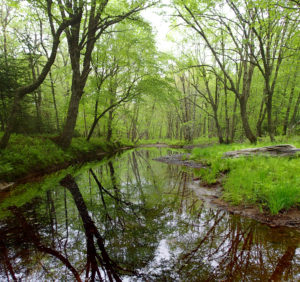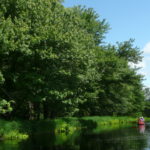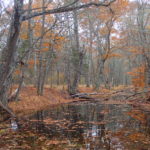International Day of Forests – Celebrating the Floodplain Forest
21 Mar 2019
by Fiona Brooks (Nature Trust Staff) & Jesse Galati (Volunteer)

In celebration of the International Day of Forests, the Nature Trust would like to pay homage to the floodplain forest. Floodplains in the Acadian forests of Nova Scotia are as beautiful as they are essential. These rare forest ecosystems are part-time wetlands; they typically develop in the low, flood-prone edges along rivers. Floodwaters deposit debris and sediments along the river’s edge eventually providing enough material to give

Vernal pool in spring
life to a diverse array of species, some of which cannot be found anywhere else. Floodplain forests provide a mosaic of micro habitats, such as, oxbow (small pools separated from the river), vernal pools (seasonal wetlands that dry up in the summer), pockets of open meadow, and dense shrub thickets.
Floodplain forests are a rare ecosystem type in Nova Scotia. Why? Because floodplains are generally flat and have rich soil making them appealing locations for settlement – Truro, Annapolis Royal, and Sherbrooke are all examples of communities that have been established in floodplains – and settlement in these areas typically involves deforestation. The good news is that there are still pockets of healthy floodplain forests in Nova Scotia and the Nature Trust has protected several unique examples of these across the province.
The Red Maple floodplain on the Pleasant River conservation lands provide critical habitat for species at risk such as Blanding’s Turtle (nationally and provincially Endangered) and Eastern Ribbon Snake (provincially Threatened). Our conservation lands on Meander River support mature stands of Sugar Maple, Red Oak, White Ash, and Yellow Birch, while the St. Mary’s River conservation lands support a slightly different species composition where Red Maples blush at the river’s edge and then become more interspersed with Red Oak as the banks creep a little higher in elevation.
So here is our ode to a very special forest type in honour of the International Day of Forests:
Oh floodplain forests, how do I love thee? Let me count the ways…
- You keep our water clean and clear – floodplain forests improve water quality by acting as a natural filter for sediment, nutrients and agricultural run-off.
- Stability in the face of change – the intricate and extensive root systems of these forests hold soil in place thereby increasing shoreline stability and decreasing erosion.
- Your spongy ways – they reduce the severity of flooding by absorbing water and then slowly filtering it back into the river system.
- You know how to keep your cool – trees gracefully hanging over the river’s edge provide shade to keep water temperatures cool and comfortable for fish living in the river, such as Atlantic Salmon, during the hot summer months.
- Sharing is caring – floodplain forests provide a rich source of food, water, habitat and travel corridors for terrestrial animals and semi-aquatic reptiles like Wood and Blanding’s Turtles.
We’re simply flooded with appreciation for these beautiful and unique forests – Happy International Day of Forests!




